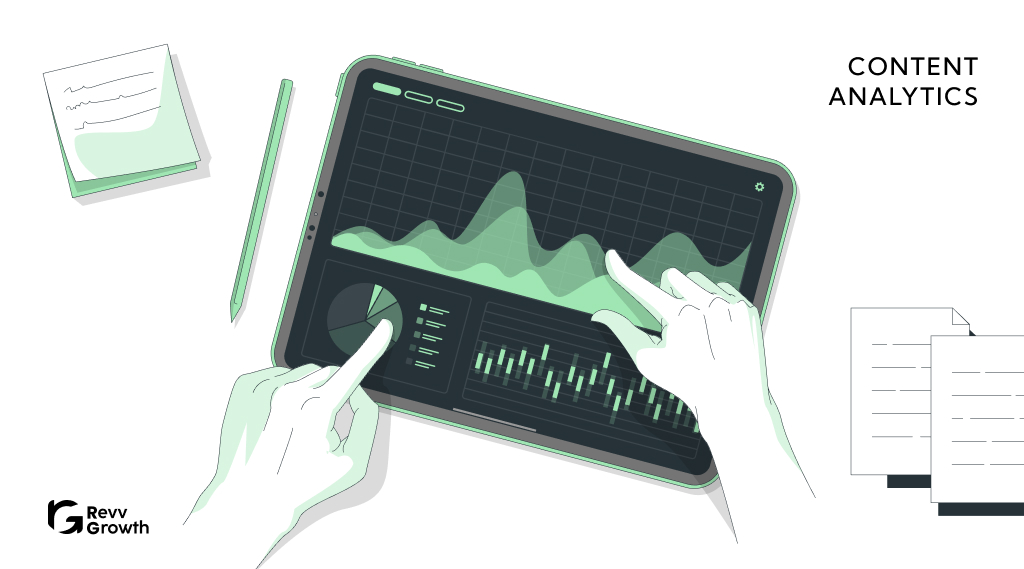Introduction
Content analytics is a method used by businesses to understand how well their content is performing and to make informed decisions about their content strategy.
Here’s a breakdown of what content analytics entails:
1. Data collection: Content analytics involves collecting data from various sources, such as websites, social media platforms, and email campaigns. This data includes metrics like page views, likes, shares, comments, and click-through rates.
2. Performance evaluation: Once the data is collected, businesses analyze it to assess the performance of their content. They look at which pieces of content are most popular, which ones are driving engagement, and which ones are falling flat.
3. Audience insights: Content analytics also provides insights into the audience consuming the content. By analyzing demographic data and user behavior, businesses can learn more about who their audience is, what they’re interested in, and how they prefer to consume content.
4. Content optimization: Armed with data and insights, businesses can optimize their content strategy. They can create more of the content that resonates with their audience and adjust their approach for content that isn’t performing well.
5. Channel effectiveness: Content analytics helps businesses understand which channels are most effective for distributing their content. Whether it’s social media, email, blogs, or other platforms, businesses can focus their efforts on the channels that yield the best results.
6. Continuous improvement: Content analytics is an ongoing process. Businesses continuously monitor and analyze their content performance, making adjustments and improvements over time to ensure they’re meeting their goals and delivering value to their audience.
What are the benefits of content analytics?
Content analytics helps you understand how well your content is performing. Here are the benefits:
1. Insight into audience behavior: Content analytics show you what your audience likes and dislikes. You can see which content gets more views, likes, and shares.
2. Improves content quality: By analyzing what works, you can create better content. You’ll know what topics are popular and what style resonates with your audience.
3. Targeted marketing: With content analytics, you can tailor your marketing efforts. You’ll know who your audience is and what they’re interested in, allowing you to create targeted campaigns.
4. Optimizes SEO: Content analytics can help improve your website’s search engine ranking. By analyzing keywords and traffic patterns, you can optimize your content for better visibility.
5. Enhances user experience: Understanding your audience helps you create a better user experience. You can tailor your content to meet their needs and preferences.
6. Increases engagement: By analyzing which content performs best, you can create more engaging material. This leads to increased likes, shares, and comments.
7. Measures ROI: Content analytics allow you to track the return on investment (ROI) of your content marketing efforts. You can see which campaigns are generating revenue and which are not.
8. Identifies trends: By analyzing data over time, you can identify trends and capitalize on them. This helps you stay ahead of the competition and keep your content fresh.
9. Optimizes content distribution: Content analytics can help you determine the best channels for distributing your content. You’ll know where your audience spends their time online, allowing you to focus your efforts accordingly.
10. Informs content strategy: Ultimately, content analytics inform your content strategy. You can make data-driven decisions about what content to create, how to distribute it, and how to measure its success.
Content analytics provides valuable insights that can help you improve your content, engage your audience, and achieve your marketing goals. By understanding what works and what doesn’t, you can optimize your content strategy for maximum effectiveness.
What are the five types of content analysis?
Content analysis is a method used to study communication and media. There are five types of content analysis. Each type focuses on different aspects of content. Let’s explore them:
1. Quantitative content analysis
This type involves counting and categorizing content. Researchers tally things like words, phrases, or themes. For example, they might count how many times a certain word appears in a text. This helps to find patterns and trends in communication.
2. Qualitative content analysis
Unlike quantitative analysis, qualitative analysis looks at the deeper meanings in content. Researchers analyze the context, tone, and nuances of the text. They aim to understand the underlying messages and interpretations.
3. Thematic analysis
Thematic analysis focuses on identifying recurring themes or patterns within the content. Researchers look for common ideas or topics that emerge across different texts. This helps to uncover the central concepts or issues being addressed.
4. Narrative analysis
Narrative analysis examines the storytelling aspects of content. Researchers study how stories are structured, what elements are included, and how they are presented. This type of analysis is often used in fields like literature, film studies, or psychology to understand the narrative techniques used to convey meaning.
5. Discourse analysis
Discourse analysis examines the language and communication practices within a particular context. It looks at how language is used to construct social realities, identities, and power relations. Researchers analyze things like word choice, grammar, and rhetorical strategies to understand how meaning is created and negotiated.
7 content analytics examples
Content analytics is about understanding information through examples. Here are seven simple examples to help you grasp its concept better.
1. Social media engagement
Imagine you have a social media account. Content analytics helps you see which posts get the most likes, comments, and shares. By understanding this data, you can learn what type of content your followers enjoy the most. For instance, maybe they prefer funny memes over serious articles.
2. Website traffic analysis
If you own a website, content analytics can show you how many people visit it each day. You can also see which pages they spend the most time on. This helps you know what content is popular and what needs improvement.
3. E-commerce sales tracking
Suppose you run an online store. Content analytics can track which products sell the best and when. It can also reveal patterns, like if more people buy during certain times of the year. This information helps you plan sales and promotions effectively.
4. Email marketing performance
When you send out emails to customers or subscribers, content analytics measures how many people open them and click on the links inside. By analyzing this data, you can understand which subject lines and content resonate with your audience, leading to better engagement.
5. Customer feedback analysis
Let’s say you receive feedback from customers through surveys or reviews. Content analytics can help you analyze this feedback to identify common themes or issues. For example, you might notice that many customers complain about slow shipping. This insight can guide you in improving your service.
6. Content personalization
Content analytics can personalize the content users see based on their preferences and behavior. For instance, streaming platforms like Netflix use it to recommend movies and shows you might like based on what you’ve watched before.
7. Predictive analytics
Predictive analytics uses past data to forecast future trends. For example, a news website might use it to predict which articles will be popular next week based on current readership patterns. This helps them plan their content strategy in advance.
Content analytics tools to try in 2024
Here’s the list:-
1. Google Analytics
Google Analytics is a popular tool used to analyze website traffic and user behavior. It offers detailed insights into how visitors interact with your website, which pages they visit most frequently, and how they navigate through your content. With Google Analytics, you can track important metrics such as the number of visitors, bounce rate, and conversion rate, helping you understand the effectiveness of your content and marketing strategies.
2. SEMrush
SEMrush is a comprehensive SEO and content marketing tool that helps you optimize your content for search engines and analyze your competitors’ strategies. It offers features such as keyword research, backlink analysis, and site audit, allowing you to identify opportunities for improving your content’s visibility and performance in search engine results pages. Additionally, SEMrush provides valuable insights into your competitors’ content strategies, enabling you to stay ahead in your industry.
3. Meltwater:
Meltwater is a powerful tool for media monitoring and social listening. It allows you to track online conversations about your brand, products, or industry across various channels, including social media, news websites, and blogs. Meltwater’s advanced analytics capabilities help you understand the sentiment surrounding your brand and identify emerging trends and topics of interest to your target audience. By monitoring mentions and sentiment, you can effectively manage your brand’s reputation and identify opportunities for engaging with your audience.
4. HubSpot:
HubSpot is an inbound marketing platform that offers a range of tools for content creation, distribution, and analytics. It helps you track the performance of your blog posts, landing pages, emails, and social media campaigns, providing valuable insights into which content resonates most with your audience. HubSpot’s analytics dashboard allows you to monitor key metrics such as traffic, leads, and conversions, helping you make data-driven decisions to optimize your content marketing efforts and drive business results.
5. Brandwatch:
Brandwatch specializes in social media listening and analytics, helping you understand how your brand is perceived online. It provides insights into brand mentions, sentiment analysis, and trending topics on social media platforms, allowing you to gauge the effectiveness of your social media content and campaigns. By monitoring conversations about your brand and industry, Brandwatch enables you to identify opportunities for engaging with your audience, addressing customer concerns, and capitalizing on emerging trends.
Conclusion
Content analytics is a powerful tool for businesses to understand and improve their digital content strategies. By analyzing data from various sources, such as websites, social media, and email campaigns, businesses can gain valuable insights into audience behavior, optimize their content, and measure the effectiveness of their marketing efforts. With the right tools and metrics, businesses can make informed decisions to drive engagement, enhance user experiences, and achieve their goals.


